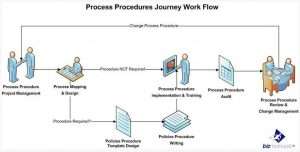Download a Free Standard Operating Procedure Sample PDF

If you’re looking for a way to streamline your business processes and ensure consistency in your operations, then you might want to consider creating a Standard Operating Procedure (SOP). To help you get started, we are pleased to offer a free Standard Operating Procedure Sample PDF for download. In this article, we’ll explore what SOPs are, why they matter, the different types of SOPs, and how to create one that works for your business needs.
Understanding Standard Operating Procedures (SOPs)
Firstly, let’s define what the SOP acronym means. SOPs are a set of step-by-step instructions that detail how standard tasks should be carried out in a company. They document important procedures and best practices, so that employees have a clear understanding of how to complete certain tasks. SOPs are essential in most businesses because they reduce the risk of errors, ensure consistent quality and save time and resources.
As businesses grow and develop, it becomes increasingly important to have a set of standard operating procedures in place. This is because as more employees are hired and more tasks are added to the company’s workload, there is a greater chance of errors and inconsistencies. SOPs help to mitigate these risks by providing clear and concise instructions that can be followed by anyone in the company.
What are Standard Operating Procedures?
Standard operating procedures (SOPs) are written instructions that provide a detailed overview of a specific task or practice in the workplace. They outline the steps necessary to complete the task, including the process flows, necessary tools or equipment, and any safety precautions that need to be taken. What is the difference between a policy, process, procedure, SOP, or work instruction?
For example, in a manufacturing company, an SOP work instruction might be created for the process of assembling a product. This SOP would include detailed instructions on how to assemble the product, which tools and equipment are needed, and any safety precautions that need to be taken. By following the SOP, employees can ensure that the product is assembled correctly every time, reducing the risk of errors and inconsistencies.
Importance of SOPs in Business Operations
SOPs are crucial for businesses as they help ensure that procedures are performed consistently, accurately, and safely. They also ensure that the company and its employees are complying with industry regulations and standards, which in turn helps to minimize risks. Documented procedures benefits not only employees but also customers, as they can feel confident that the products or services they receive meet the highest quality standards.
Furthermore, SOPs can also help to improve efficiency in the workplace. By providing clear and concise instructions, employees can complete tasks more quickly and with fewer errors. This can save the company time and resources in the long run.
Key Components of an Effective SOP
Creating an SOP requires careful consideration of each step in the process. There are key components that must be included in any SOP to ensure that it is effective, including clearly stating the purpose of the SOP, assigning responsibility, listing necessary materials, and setting measurable objectives. Additionally, SOPs should be reviewed regularly and updated if required to ensure they maintain relevance and accuracy.
Another important component of an effective SOP is ensuring that it is easily accessible to employees. This can be achieved by storing the SOP in a central location, such as an online database or shared drive, and providing employees with clear instructions on how to access it.
In conclusion, SOPs are an essential component of any business operation. They help to ensure consistent quality, reduce the risk of errors, and save time and resources. By following the key components of an effective SOP, businesses can create a set of procedures that are clear, concise, and easily accessible to all employees.
Types of Standard Operating Procedures
Standard Operating Procedures (SOPs) are an essential part of any organization as they provide a set of guidelines for employees to follow when carrying out their daily tasks. There are three main types of SOPs: process-based, procedure-based, and task-based.
Process-based SOPs
Process-based SOPs are designed to detail a specific process or workflow in a company. They explain how to complete procedures that are completed as a sequence, such as manufacturing goods or delivering a service. These SOPs are particularly useful in ensuring that the process is standardized and consistent, which can help to increase efficiency and reduce errors.
For example, a process-based SOP for a manufacturing company may detail the steps required to produce a product, including the materials needed, the machinery to be used, and the quality control checks required at each stage of the process. By following this SOP, employees can ensure that the product is produced to the same standard every time, reducing the risk of defects or inconsistencies.
Procedure-based SOPs
Procedure-based SOPs are more detailed and explain how to complete a specific procedure within a process. For example, how to check the measurements of a newly manufactured product. These SOPs are useful in ensuring that employees are aware of the specific steps required to complete a task correctly and efficiently.
Procedure-based SOPs can be particularly useful in industries where precision is essential, such as the healthcare or pharmaceutical industries. In these industries, a small mistake in a procedure can have serious consequences, so it is essential that employees are aware of the correct steps to take.
Task-based SOPs
Task-based SOPs are more specific and outline how to complete a single task or activity in the work process, like a standard operating procedure checklist. These may also be called a work instruction and include things like how to operate a specific machinery or how to conduct a safety inspection on the work floor.
Task-based SOPs are particularly useful in industries where employees are required to carry out a range of different tasks, such as in the construction or manufacturing industries. By providing detailed instructions on how to complete each task, employees can ensure that they are carrying out their work safely and efficiently.
In conclusion, SOPs are an essential part of any organization, and there are three main types of SOPs: process-based, procedure-based, and task-based. By using SOPs, organizations can ensure that their processes are standardized and consistent and that their employees are aware of the specific steps required to complete their tasks safely and efficiently.
Steps to Create a Standard Operating Procedure
Creating a standard operating procedure (SOP) is a crucial step towards streamlining your business processes and ensuring efficiency in the long run. Here is a detailed guide on how to create an SOP:
Identifying the Need for an SOP
The first step in creating an SOP is to identify the need for it. Look out for trends in errors or poor performance, as well as tasks that occur routinely. This will help you determine the crucial aspects of the SOP such as its goals, the users, and the resources needed for the SOP.
For instance, if you notice that the same mistakes are being made repeatedly in a particular department, it may be time to create an SOP to address the issue. Similarly, if you have a new employee who needs to be trained on a particular task, an SOP can help ensure that they are trained effectively.
Assembling a Team of Experts
The next step is to assemble a team of experts to help create the SOP. These may include the department manager, supervisors, and employees who are familiar with the process being documented. It is important to have a diverse team that can provide different perspectives and insights into the process.
The team should work together to identify the steps involved in the process, potential roadblocks, and the best practices to follow. This collaboration will help ensure that the SOP is comprehensive and effective.
Documenting the Process
The third step is to document the process using flowcharts, pictures, and text descriptions. This is a time-consuming step, but it is important to ensure clarity and detail.
Flowcharts are particularly useful for illustrating the steps involved in the process and the order in which they should be completed. Pictures and text descriptions can be used to provide additional details and clarify any potential confusion or ambiguity. It is important to ensure that the language used in the SOP is clear and concise, and that any technical terms or jargon are explained.
Reviewing and Approving the SOP
The fourth step is to have the SOP reviewed by all stakeholders. This includes the team that helped create it, as well as any other relevant parties such as management or legal teams. Once approved, it should be easy to read and follow. It is important to ensure that the SOP is consistent with any relevant laws or regulations, and that it is aligned with the overall goals of the business.
Implementing and Training Employees on the SOP
The fifth step is to implement the new SOP, ensuring the team is trained on all aspects of the SOP. Employees should be provided with clear information about their roles and responsibilities, as well as any changes that need to be made to their work processes.
Training should be conducted in a way that is engaging and interactive, and employees should be given the opportunity to ask questions and provide feedback. It is important to ensure that the SOP is easily accessible to all employees, and that it is regularly updated as needed.
Regularly Updating and Improving the SOP
The final step is to regularly review, update, and improve the SOP. Businesses and industries transform over time; therefore, ensuring that the SOP stays relevant and up-to-date is vital for its success.
Regular reviews can help identify any areas where the SOP can be improved, or where changes need to be made to reflect new processes or technologies. By following these steps, you can create an effective SOP that will help streamline your business processes and ensure long-term efficiency.
Free Standard Operating Procedure Sample PDF
An effective SOP can contribute to the success and efficiency of a business by simplifying and streamlining procedures. Following the steps listed above to create an SOP will enable businesses to implement a system of coherent standard operating procedures that ensure staff members are confident and well-informed. Download our free Standard Operating Procedure Sample PDF to obtain a framework that can help you get started on the road to creating an SOP fit for purpose.















very detailed
so nice
good